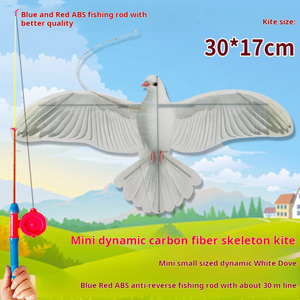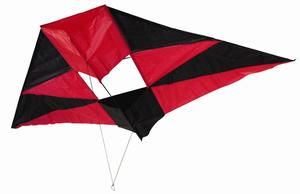(24615 products available)















































































































































































Kites kite comes in different types, each with its unique style, design, and purpose. Here are some common types of kites:
Stunt kites
These are dual or multiple line kites designed for performing tricks and maneuvers in the air. They are highly maneuverable and can be made to do spins, loops, and other aerial stunts by pulling on the lines. Stunt kites are popular among kite enthusiasts who enjoy aerobatic flying. These kites are typically made from durable fabrics like ripstop nylon or polyester and feature precise control systems with dual or multiple lines.
Box kites
These kites have a three-dimensional box structure that provides excellent stability and lifting power, even in light winds. Box kites come in various designs, including simple cubes and more complex geometrical shapes. These kites are often used for recreational flying and can be seen in kite festivals. Box kites are made from lightweight materials like plastic, paper, or fabric, with a framework of sticks or struts that create their box-like shape.
Parafoil kites
These kites don't have a rigid frame. Instead, they use air to inflate and shape the kite. Parafoil kites are compact, easy to transport, and have excellent performance in various wind conditions. They are popular for power kiting and recreational flying. Parafoil kites are made from ripstop nylon or similar fabrics that can hold air. When inflated, the kite takes on a wing-like shape, providing lift and stability.
Single line kites
These kites are controlled using a single line. They are suitable for children and beginners. Single-line kites come in various shapes and designs, from traditional diamond shapes to more exotic animals and characters. These kites are designed for casual flying and are easy to launch and operate. Single-line kites are often made from lightweight materials like plastic, paper, or fabric, with a simple frame and a basic bridle system. They are meant to be enjoyed by people of all ages, and their simplicity makes them a popular choice for family fun in the skies.
When selecting a kite for sale, business owners should consider the skill level of their customers. They should stock kites that are easy to fly for beginners. Also, they should get models that are stable and responsive for experienced flyers. Moreover, buyers should consider the wind conditions when choosing a kite. In this case, they should get kites suitable for low and high wind conditions. To attract more customers, business owners should stock kites in different sizes. They can also get kites that are designed for multiple flyers.
Business owners should examine the construction and material of the kites before making a purchase. They should choose kites made of durable materials like ripstop nylon and polyester. Such kites are able to withstand varying weather conditions. Also, they should check if the kites come with reinforced stitching and sturdy frames. To cater to customers with different preferences, buyers should get kites with different designs and themes. They can get kites with traditional, colorful patterns and modern, sleek designs. Furthermore, they should get kites with customizable options where customers can choose their graphics.
Buyers should consider the ease of assembly and installation of the kites. They should get models that can be set up quickly without the need of special tools. Also, they should get kites that come with clear instructions and guides. To cater to customers who are looking for a complete kite flying experience, buyers should get kites that come with additional accessories. They can also get kites that come with optional accessories like storage bags, tail and other decorative elements. Business owners should consider the kites' portability when choosing a kite. They should get models that are foldable and lightweight.
To attract more customers, buyers should get kites suitable for various occasions. For instance, they can get competition-ready kites and recreational kites. Also, they should get kites suitable for different age groups. Finally, buyers should consider the kites' aesthetic appeal. In this case, they should get kites with eye-catching designs that can draw customers' attention.
Kite flying is a recreational activity that many people globally participate in. Different types of kites serve various purposes, such as:
Leisure kites
These kites are for fun and enjoyment. They come in many designs and sizes, making them suitable for both children and adults. People use leisure kites when participating in kite festivals or when flying them in backyards or parks.
Stunt kites
Stunt kites are also known as dual-line kites. They are for tricks, maneuvers, and acrobatic stunts. These kites have dual lines, giving the flyer complete control over the kite's movements. Stunt kites are perfect for people who want to engage in competitive kite flying or perform aerial tricks.
Sport kites
Sport kites are for organized competitions and aerial sports. They have advanced designs that allow precision flying and aerial maneuvers. These kites are for people interested in sport kite competitions, such as ballet, precision flying, and team flying.
Power kites
Power kites are large and are for traction and power generation. They are for activities such as kiteboarding, kitesurfing, and snow kiting. These kites are for adventurous people who want to use kites in conjunction with other outdoor sports.
Decorative kites
These kites are for cultural displays and artistic purposes. They come in elaborate designs and vibrant colors. People use these kites during traditional celebrations, cultural festivals, or artistic exhibitions.
Kites have various features depending on their design and intended use. Here are some common features of a few types of kites:
Recreational kites:
Recreational kites have simple designs. They feature lightweight materials such as plastic or nylon. These kites come with basic instructions, and their assembly is easy. They have vibrant colors and eye-catching designs. Also, they have a straightforward line control system.
Stunt kites:
Stunt kites have dual-line control systems. This feature allows precise maneuverability. These kites have durable materials like ripstop nylon or polyester. Additionally, they have aerodynamic designs that offer accurate responses to pilot inputs. Also, they have adjustable bridle systems that allow customization of flight characteristics. These kites come with detailed instruction manuals for assembly and flying. Moreover, they have carry bags for storage and transportation.
Power kites:
Power kites have large surface areas for maximum power generation. They come with robust materials such as high-density ripstop nylon. These kites have harnesses and control bars for safe and effective flying. Additionally, they have inflation systems for foil kites to enhance stability and shape retention. Power kites also have safety features like depower systems and release mechanisms to prevent accidents.
The design of a kite determines its performance and suitability for various activities. Here are the key components that make up a typical kite design:
Frame:
The frame of the kite is its skeleton. The frame is from lightweight materials such as fiberglass, carbon fiber, or bamboo poles. The frame determines the kite's shape, size, and structure. Also, it affects the kite's strength, flexibility, and weight.
Bridle:
The bridle is the framework that supports the frame. The bridle is from string or cord materials. The bridle system is complex and allows accurate positioning of the tow point. A properly designed bridle system ensures the kite can achieve stable flights.
Covering:
The kite covering comes in various materials. They include nylon, polyester, paper, and plastic. The material selected affects the kite's durability, wind resistance, and aesthetic appeal. Additionally, the covering features wind sails that help in lifting the kite.
Proper Handling
Kite flying necessitates using the correct equipment and techniques. This includes employing a stable spool and line that can withstand the pressure. Additionally, one should learn how to maneuver and control the kite to avoid accidents.
Environmental Awareness
People should be aware of their surroundings when flying a kite to avoid collisions with structures, power lines, or other objects that may pose a threat. Additionally, choosing open and safe spaces for flying kites is essential.
Wind Conditions
Stable wind conditions are crucial for kite safety. Windy conditions can lead to a loss of control, which can damage the kite and create safety hazards. Therefore, it is essential to check the weather and ensure the wind is appropriate for flying kites.
Regulations and Respect
One should respect local rules and regulations regarding kite flying. This includes avoiding no-fly zones and obtaining permission to fly in particular areas. Additionally, it is important to respect other people's spaces to avoid conflicts.
Material
A high-quality kite is made of durable, lightweight materials such as ripstop nylon or polyester for the sail. Additionally, strong materials like fiberglass or carbon fiber are used for the frame.
Design and Aerodynamics
Kites with well-designed shapes and aerodynamic features fly better and are more stable. Designs that minimize drag and maximize lift allow the kite to perform well in various wind conditions.
Construction and Craftsmanship
Quality kites have precise and consistent craftsmanship, which includes well-sewn seams and proper alignment of components. Moreover, reliable kites have strong connections and fittings that are essential for both the frame and the sail.
Line and Spool
The line used in quality kites is strong, thin, and highly durable, which minimizes the amount of wind drag. Additionally, the spools or reels should allow for smooth winding and unwinding of the line while preventing tangles.
What materials are used in making kites?
Kites are made from a variety of materials depending on their design and type. The frame, which gives the kite its structure, is often made from lightweight materials such as fiberglass, bamboo, or carbon fiber rods. These materials are chosen for their strength and lightness, which help the kite maintain its shape in the air. The covering material is typically a strong, lightweight fabric like ripstop nylon or polyester. For more traditional or decorative kites, paper or plastic can also be used as covering materials.
Are kites suitable for children to fly?
Absolutely, kites kite can be an excellent outdoor activity for children. However, it's crucial to choose the right type of kite for their age and ensure they have proper supervision. Easy-to-fly kites, such as single-line kites, are recommended for younger children. It's also important to teach them safety measures, like avoiding power lines and being cautious around traffic. With the right precautions, kite flying can be a fun and safe experience for kids.
How can someone repair a damaged kite?
The repair process of a damaged kite depends on its construction. For kites made with fabric like ripstop nylon, small tears can be sewn or patched using fabric adhesive. If the frame is broken, especially in fiberglass or carbon fiber kites, it may require splicing or replacing the damaged part. It's always good to have a repair kit specific to the kite type, which includes patches, glue, and tools for frame repair.
What are the environmental impacts of kites?
Kites can have environmental impacts, particularly when they are made from non-biodegradable materials and are flown in large numbers. Those made with plastics and synthetic fabrics can contribute to pollution if they are discarded carelessly. Additionally, if they are flown in areas with wildlife, they can pose risks to birds and other animals, potentially leading to habitat disruption.